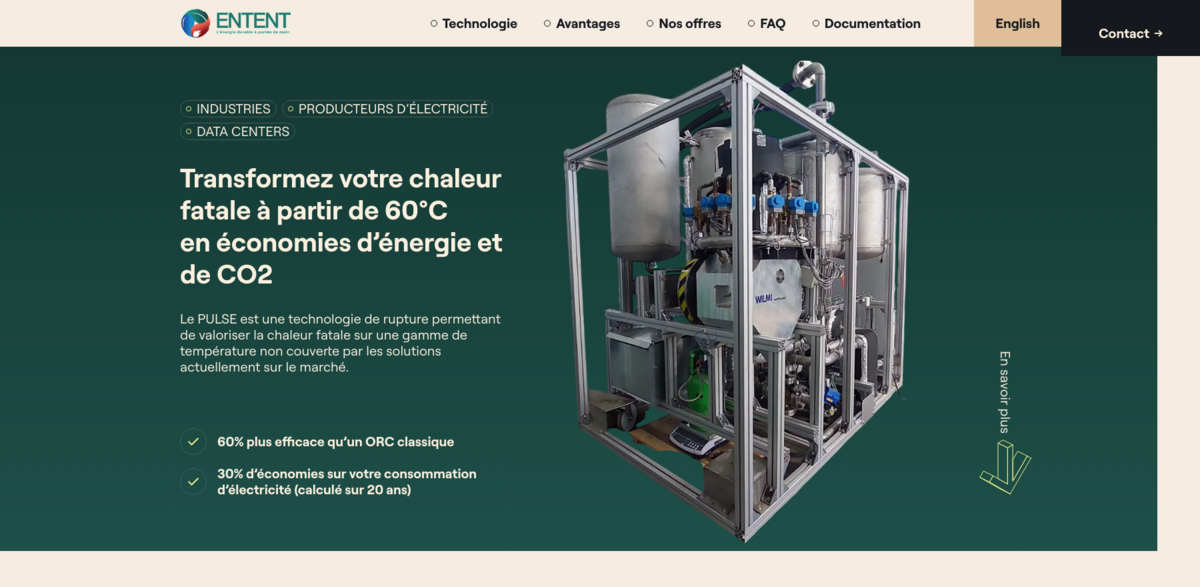What Is the Project?
Transform your waste heat from 60°C into energy and CO2 savings. This breakthrough technology, known as the PULSE, is designed to valorize waste heat over a temperature range not covered by current market solutions. Born from the need for sustainable development and the decarbonization of industry, the project provides an innovative approach to converting low-temperature waste heat (60°C to 150°C) into useful electricity. ENTENT, a cleantech startup co-founded by Mathias Fonlupt and Stéfán R., has been working on this concept since 2018. The project harnesses a new thermodynamic cycle with ORC cousin technology, ensuring that even the heat typically lost in industrial processes is put to good use. It’s an engine that not only makes energy production more efficient but also tackles the environmental footprint of industrial activities.
Main Benefits
- 60% more efficient than a conventional ORC
- 30% savings on electricity consumption (calculated over 20 years)
- Recovery of waste heat between 60°C and 150°C, covering 30% of industrial waste heat
- Production of 800 MWh/year per machine
- Avoidance of up to 350 tons of CO2 emissions per machine per year
This list of key figures and facts brings a clear perspective on the benefits of the PULSE technology – impressive, isn’t it?
Innovative Technology
The PULSE utilizes a new thermodynamic cycle that stands out by being effective from as low as 60°C to 150°C. This narrow yet crucial range had long been overlooked by conventional energy recovery systems, which left a significant amount of waste heat untapped. Picture this: 20% to 50% of the energy consumed by industry ends up as lost heat every day. Until now, no other solution on the market could transform this low-temperature waste into electricity. By bridging this gap, the PULSE is not just an engine – it’s a technological game-changer that redefines how waste heat is perceived in the industrial realm. The casual brilliance of this technology lies in turning what was once considered a lost resource into a valuable asset.
Versatile Applications
The technology’s adaptability is another highlight worth mentioning. The PULSE is designed to adapt to the nature of the vector, thermal power, temperature, and various site constraints. Whether it is industrial companies, data centers, energy producers, or geothermal power plants, this engine can be integrated with virtually any system that suffers from low-temperature waste heat loss. The design can easily be adapted to precarious or isolated networks, making it a perfect choice for regions where robust energy systems are hard to come by. It’s as if the technology is speaking in a language that every industrial setup understands, ensuring energy efficiency improvements across various sectors.
Design Flexibility & Scalability
Delivered in a containerized format with a limited footprint (2.5m x 2.5m), the PULSE is a marvel of compact engineering. Its weight varies depending on the installed power, and several units can be coupled to increase production capacity. This modularity guarantees that the system scales gracefully with the evolving needs of any facility. The innovation behind the PULSE is grounded in practical design solutions that take into account space constraints and the ever-changing requirements of energy production facilities. This flexible approach makes it easier to implement, allowing for incremental investments that yield substantial long-term benefits.
Sustainable Industrial Transformation
This project is more than just an innovative engine; it is a definitive step towards decarbonizing the heavy industry. With the stark reality that wasted heat accounts for a significant inefficiency in industrial energy consumption, the PULSE paves the way for cleaner, more efficient operations. The transformation involves not just cutting-edge engineering but also a commitment to sustainable practices that ensure industries are aligned with global environmental goals. In an industry where every degree matters, recovering heat between 60°C and 150°C is a breakthrough that cannot be overstated.
Project Impact
- SDG 7: Affordable and Clean Energy – By converting waste heat into electricity, the project supports the drive for efficient, renewable energy sources.
- SDG 9: Industry, Innovation and Infrastructure – Incorporating advanced thermodynamic cycles is a leap forward in industrial innovation and infrastructure resilience.
- SDG 13: Climate Action – Avoiding up to 350 tons of CO2 emissions per machine per year contributes significantly to combating climate change.
These SDGs reflect the core impact of the project, aligning it closely with the broader goal of achieving a sustainable future.
Future Outlook
Looking ahead, the promise of the PULSE and similar waste heat valorisation engines is enormous. The way industrial plants, data centers, and energy producers benefit from such transformative technology could lead to a complete rethinking of energy recovery strategies across the globe. Over the coming years, more industries will likely adopt these systems, driven by both economic incentives and the pressing need to reduce carbon footprints. This innovative approach, with its casual yet steadfast drive, signals a practical shift towards a greener and more sustainable industrial landscape. Given the current trajectory, the future is humming with energy – energy that was once wasted, now reclaimed to power progress.





















